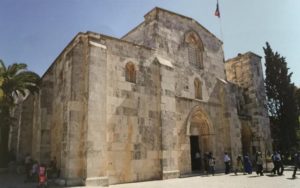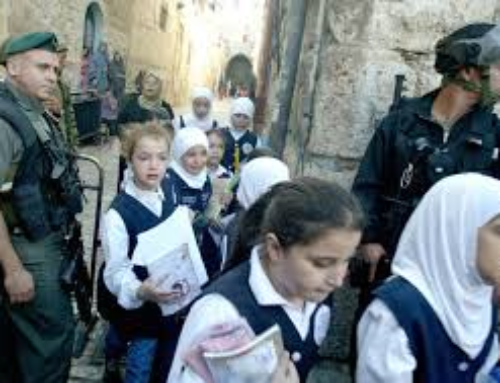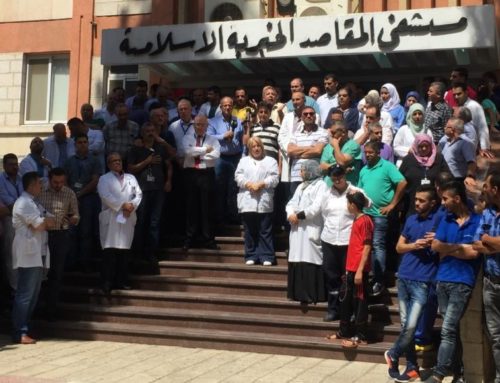Jerusalem has been a center for religious education due to the religious status it holds. Successive Islamic eras, starting with the early Umayyad and ending with the late Ottoman, established educational institutions in Jerusalem. In the late Middle Ages, religious schools in Jerusalem and in other Islamic capitals and central provinces, adopted the positions of mosques and played a key role in shaping the cultural and scientific component therein.[1]
Jerusalem once had 50 religious schools that offered higher education in different subjects. [2] Al-Aqsa Plaza has fifteen religious schools on its own, most of which were established during the Ayubid and Mamluk eras.[3] One of the most famous religious schools in Jerusalem is the Salahi School (Al-Salaheiah). This school was established in 1187 after Saladin liberated Jerusalem from the Crusaders and existed as a school up until 1917, when the United Kingdom put Palestine under the mandate.[4] Many schools were either destroyed or changed function, while few others remain open to this very day. This article addresses the history, evolution and functions of such schools.

History and Evolution
Many of the religious schools Jerusalem had or still has were established by Sultans, religious figures and scientists. Such schools were not limited to men, as they were open to women as well, and individuals were able to acquire their education at these institutions. Women were not only educated at the schools; they also helped establish them. A number of the most famous schools in Jerusalem were actually built by rich women, such as the Ottoman School which was built by Asfahan Shah Khatoon and the Khatoni School which was built by Anml Khatoon, daughter of Shams Al-Din Al-Baghdadi.[5]
At the beginning, religious schools were dedicated to teaching Islamic Studies, such as the Quran, Hadith, and Islamic jurisprudence.[6] Later on, however, religious schools started teaching many other specializations, especially in the field of science, introducing classes such as math, space and medicine. [7] Scientists and thinkers from all over the Islamic world came to teach or to get higher education in those schools, and many books were written on religion, geography, history and science.[8]
At the time of the Mamluks, a radical change happened to the religious schools system in Jerusalem. Not only did the number of religious schools in existence increase rapidly, they became more sophisticated, modern and well organized. Mamluk sultans and princes built many religious schools and endowed them lands, baths, markets, and buildings to serve and provide for students and residents.[9]
In addition to this, Mamluks imposed complex administrative regulations on schools in terms of expenses, hiring requirements, staff training and functions, rights and responsibilities of faculty, graduation requirements, and courses taught in the schools.[10]
Sufi Religious Schools
Different sects established their own religious schools. More particularly, Sufis had, and still have, a number of distinctive religious schools in Jerusalem where Sufism is being taught.[11] Sufis indeed had the most diverse religious schools in Jerusalem. A Nook (Zaweiah) is one type of Sufi school that was revived at the time of Mamluks. The most famous nook schools are Al-Qadreiah, Al-Majeedeiah, and the Indian Nooks in the Old City of Jerusalem.[12]
Sufis also had another type of religious schools in Jerusalem; the Ribat Schools. Such schools were used to educate Sufis and host visitors, poor people and non-residents of Jerusalem. The most famous Ribat schools in Jerusalem were Al-Basiri, Al-Mansouri, and the Kurdish, all of which were turned into residential homes for Arab families in the city. One Ribat school, Bayram Shawish, was turned into the Islamic orphanage in Jerusalem.[13]
Lastly, Sufis had a type of religious schools called Khanqah in Persian or Takeiah in Turkish. This type of school was revived under Ottoman rule. The most famous of is the Daoudria School.[14]
Current Status
Religious schools in Jerusalem are not a mere historical mark, rather they are a distinctive cultural one. Many modern religious schools have been established recently in Jerusalem, while other more ancient and historical ones were turned into residential homes for Jerusalemite families.[15] Many of the historical schools were also turned into religious institutions and centers for Islamic Endowment Department. Some of the schools were destroyed over the years, however, some of the schools that are still in operation in Jerusalem such as the Omari, Al-Qadesiah, Al-Tenkiziah, Al-Afdaleiah, and Al-Fakhreiah Schools.[16]
[1] Mohammad Qazza and Latifa Abd Al-Latif, Neighborhoods of Jerusalem, p 52
[2] Shawkat Hijjih and Othman Al-Tel, Tankizi School in Jerusalem: a Model for Administrating Schools in the Mamluk Era (Anakra University: 2015), p 78
[3] “Schools of Al-Aqsa Mosque,” at https://www.aljazeera.net/encyclopedia/citiesandregions/2016/3/8/مدارس-المسجد-الأقصى
[4] Rowaida Ahmad, Salahi School in Jerusalem (Nablus: Al-Najjah University, 2015), p 16
[5] Qazzaz and Abd Al-Latif, Neighborhoods of Jerusalem, p 52
[6] “Historical Schools in the Old City of Jerusalem,” at http://alqudsgateway.ps/wp/?cat=40
[7] Schools of Al-Aqsa Mosque
[8] Palestinian National Authority Ministry of Information, Al-Quds Sights and Landmarks (2015),p 52-53
[9] Hijjih and Al-Tel, Tankizi School in Jerusalem, p 78
[10] Id p 79
[11] Historical Schools in the Old City of Jerusalem
[12] Jerusalem International Organization, Landmarks of Old City of Jerusalem p 30-31 and Aref Al-Aref, History of Jerusalem (Jerusalem: Al Andalusia Library, 1999 fifth edition), p 236-255
[13] Id
[14] Id
[15]Schools of Al-Aqsa mosque
[16] Ministry of Information, Sights and Landmarks, p 53 and Abd Allah Najeeb Salem, Glory of Holy Jerusalem, p 154
Pictures:
- Al-Isa’ardi School in Jerusalem at https://www.aljazeera.net/encyclopedia/citiesandregions/2016/3/8/مدارس-المسجد-الأقصى
- Salahi School at https://www.turkpress.co/node/11953







